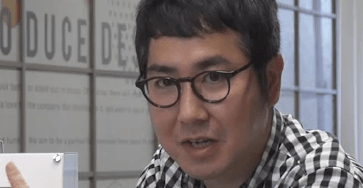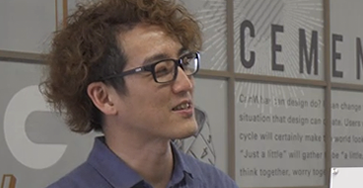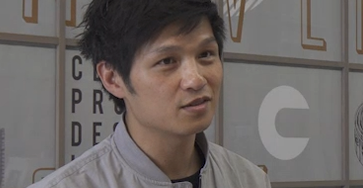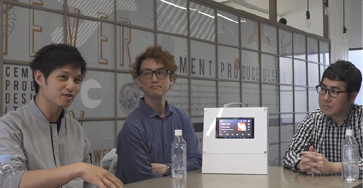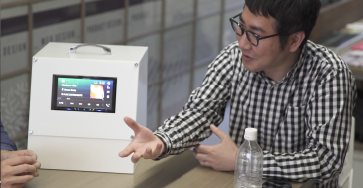INTERVIEW 01
The design goals
for the new AV receiver
INTERVIEW 02
The process of connecting
the UX and UI with the final design
INTERVIEW 03
Connecting with the market
and the end-users
INTERVIEW 04
The future of animation
and UX design
INTERVIEW 05
Pioneer's commitment
to function and form with
the new AV series receivers
The future of animation and UX design
Q: How will UX evolve in the near future?
Roy:
I feel that UX will become more and more seamless as time goes on. The products that surround us will act as extensions of ourselves and the division between human and product will blur. This is the calm before the storm - where we are still figuring out our changing relationship with technology. Smartphones and websites are a part of life these days and they got that way because users keep learning how to integrate new technologies into their lives. This means that the kind of products we want are the ones that adapt to our individual sensibilities.
Kakimoto:
There was a time, quite recently, when UI was about fixating on using graphical elements. For example, fiery backgrounds rendered to look like they are burning in real time and such. Now, instead of only having our product focus on merely displaying graphics through the screen, our design is focused on using the whole product to deliver the car audio experience. This is the philosophy behind the design concept for this product. These days people don't even look at the screen of their car audio when they're driving.
Akatsu:
Yes, that's true.
Kakimoto:
Most people don’t stare at the screen while they use the graphical interface. It's something they do with very little attention or thought and I personally think that the eventual goal should be to get rid of the GUI altogether.
Akatsu:
Technology will become so advanced that the user just thinks "I want this", and devices will respond automatically.
Kakimoto:
Exactly. A car with AI technology could play music based on voice commands and drivers wouldn't even have to glance at a screen and this results in safer driving.
Akatsu:
Good point.
Kakimoto:
What will never change is people in their car listening to good music and having a good time with their friends and family, and design will always be a part of that in some fashion. Though, design itself will likely evolve and become a different concept than how we think of design today.
Akatsu:
Right, I see what you mean.
Kakimoto:
The ultimate car driving experience. The absolute best way to enjoy being in your car - a way that is safe and fun. One of our goals is to make that happen.
Akatsu:
This might sound strange, but for comics and animation, that coming to pass could create difficulties.
Kakimoto:
Oh? In what way?
Akatsu:
For example, in manga, people are used to seeing switches being flipped. If manga artists don't show a simple flip, it becomes this dramatic action with the character yelling out as they throw their arm towards the switch.
Kakimoto:
Right, right. (Laughs)
Akatsu:
If UI disappears, this type of action will disappear as well. Let's imagine an animated giant robot show where the pilot's brain is linked directly to the robot. The robot moves as the pilot does and by showing the pilot making those movements, the audience can easily connect with what is happening. If you lose the graphical nature of UI, it will be more of a challenge to make that connection and we run the risk of confusing readers.
Kakimoto:
When it comes to 'movement', there are facets that shouldn't be replaced. Even as technology continues to change, some users will always want the physicality of pressing buttons and turning a steering wheel. In regards to those desires, we are interested in only changing the look of how they are met, but the desires themselves are unlikely to change much. You mentioned the character yelling out as they flipped a switch and something like that might just change into something else.
Akatsu:
You mean something will appear to replace that action?
Kakimoto:
The flipping of the switch won't change, but maybe the method, the yelling part, that might change.
Akatsu:
I wonder how the kids of the future will play pretend. (Laughs) It's amazing to think that our current experience of physicality could someday disappear.
Kakimoto:
It's like how just a few years ago, you didn't have the touch screens like you have with smartphones. Due to that development, you no longer have to include certain parts that you had to turn, or manipulate like a dial. When it comes to your car, however, there are situations where it's much easier to turn a dial instead of touching a screen. So, though changes are made to some elements of the physicality, there are some elements that just won't change. Our job is to recognize which is which.
Akatsu:
I see.
Kakimoto:
We are constantly considering usability and safety factors. We always have to have an understanding of why each piece has to be in the place we put it and what we can and can't change. This is reflected in how we put together the new AV receiver series.
to be continued Vol.5
